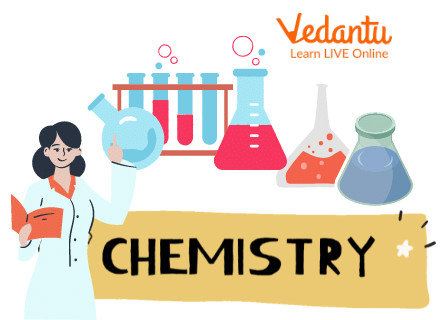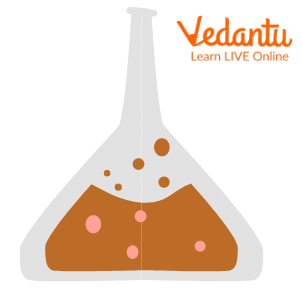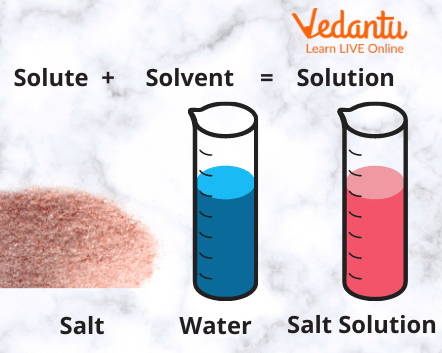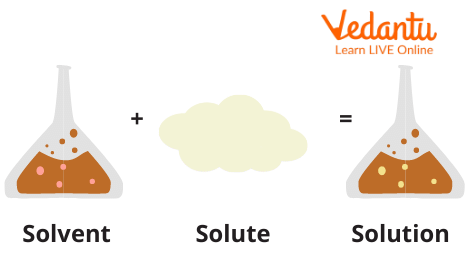




Overview of Solute and Solvent
Have you ever wondered why is it always said to mix sugar or salt in water? Why can’t you mix one tablespoon of water with a glass of sugar? What will happen then? So, this is about solute and solvent which make a solution on mixing.
In this article, we will learn what is solute and solvent and also discover some solute and solvent examples. Let's dive into the article to understand this topic better and start with a solution. The solution is something that is made by mixing solute and solvent. Let’s start with some more scientific definition of it.

Solute and Solvent
What is a Solution?
A uniform mixture of solutes dissolved in a solvent is a solution. A mixture of two or more components with a uniform appearance and composition is referred to as a homogeneous solution. If one tablespoon of sugar is mixed with one glass of water, then it makes a homogeneous mixture having sugar as solute and water as solvent.

Solution
Examples of Solution
Here are a few examples of solutions.
Seawater (Solid in Liquid)
Vinegar (Liquid in Liquid)
Carbonated Drinks (Gas in Liquid)
Air (Gas in Gas)
What is Solute?
The component dissolved in a fluid to form a solution is known as a solute. The solute concentration is a deciding factor in determining whether the solution is solid, liquid, or gaseous.
Examples of Solute
Listed below are a few examples of solutes.
Almost all metallic salts
Sugar
Edible Salt
What is a Solvent?
A solvent is usually a liquid that is used to dissolve a solute. It is a liquid that dissolves other components to generate a solution. Now, ion production is favoured by polar solvents like water but not by nonpolar solvents like hydrocarbons. Water is a good example of a solvent.
Classification of Solvents
Solvents can be classified into Polar (example water) and Non-Polar (example, hydrocarbons) solvents.
Polar and Non-Polar Solvents
Ion formation is aided by polar liquids. Ions do not form in non-polar liquids. The dielectric constant describes a solvent's ability to generate ions. Water has a relatively high dielectric constant. Due to water's high dielectric constant, compounds with ionic bonds will tend to dissociate in water, resulting in ion-containing solutions.
Examples of Solute in Solvent
The following are a few examples of solutes and solvents.
Sugar and water (sugar solution)
Salt and water (salt solution)
Sand and water (sand solution)
Difference Between Solute and Solvent

Solute, Solvent and Solution
The difference between solute and solvent can be determined based on their definition, physical appearance (basically a state of matter:- solid, liquid, or gas form), solubility, and boiling point. Let us see how!
Firstly have a look at the definition of physical state, solubility and boiling point for better understanding.
Physical State: Physical state refers to the state that defines a substance's shape (gas, liquid, or solid) at a given temperature and pressure. The solute can be solid, liquid or gas, but solvents are mostly liquid; only some are gas or solid.
Solubility: The ability of a certain material, the solute, to dissolve in a solvent is referred to as solubility. Solubility of solute is determined by its surface area and molecular size, whereas solubility of solvent is determined by its polarity.
Boiling point: The boiling point for any material is the temperature point at which the material transforms into the gas phase from the liquid phase. The boiling point of the solute is higher, but the boiling point of the solvent is lower.
The difference between solute and solvent is given below:
Summary
It is the solvent's role to dissolve the solute, not the other way around. Solutions can be made with a huge variety of solutes and solvents. A mixture of two or more dissolved compounds in a liquid medium is a solution. To distinguish them from heterogeneous mixtures (many compounds exist in various configurations), solutions are homogeneous, which means that the atoms of the solute are evenly dispersed throughout the solvent (e.g., water, ethanol). We are aware of a wide range of solutions discussed in the article.

Solute, Solvent, and Solution
FAQs on Solute and Solvent
1. Give a few examples of solutes.
Salt and water are two examples of solutes. As the salt dissolves in water, thus, it is the solute. Examples of solutes include almost all metallic salts, sugar, and edible salts.
2. Why is water a good solvent? Give a few examples of solvents. What is a solution?
Water is an excellent solvent, capable of dissolving a wide variety of compounds due to its polarity and capacity to create hydrogen bonds. Water is the best example of a solvent because of this, thus, making it a good one. A uniform mixture of solutes that have been dissolved in a solvent is a solution. Examples include brine and seawater.
3. What is the solvent in a cup of milk?
Solutes: caffeine, sugar; and milk proteins
Solvent: Water









